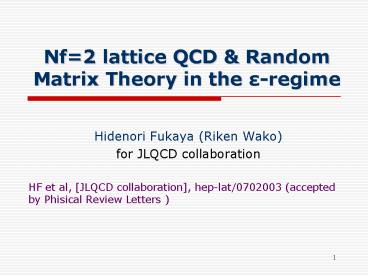Nf=2 lattice QCD - PowerPoint PPT Presentation
1 / 18
Title: Nf=2 lattice QCD
1
Nf2 lattice QCD Random Matrix Theory in the
e-regime
- Hidenori Fukaya (Riken Wako)
- for JLQCD collaboration
- HF et al, JLQCD collaboration, hep-lat/0702003
(accepted by Phisical Review Letters )
2
1. Introduction
- JLQCDs overlap fermion project (-gtNoakis talk)
- On a 163 32 lattice with a 1.6-1.8GeV (L
1.8-2fm), - we have achieved 2-flavor QCD simulations with
- the overlap quarks with the quark mass down to
3MeV. - NOTE m gt50MeV with non-chiral fermion in
previous JLQCD works. - Iwasaki (beta2.3) Stop(µ0.2) gauge action
- Overlap operator in Zolotarev expression
- Quark masses ma0.002(3MeV) 0.1.
- 1 samples per 10 trj of Hybrid Monte Carlo
algorithm. - 5000 trj for each m are performed.
- Q0 topological sector (No topology change.)
3
1. Introduction
- Systematic error from finite V and fixed Q
- Our test run on (2fm)4 lattice is limited to a
fixed topological sector (Q0). Any observable is
different from ?0 results - Brower et al, Phys.Lett.B560(2003)64
- where ? is topological susceptibility and f is
an unknown function of Q. - ? needs careful treatment of finite V and fixed
Q . - Q2, 4 runs are started.
- 24348 (3fm)4 lattice or larger are planned.
- Check of ergodicity in fixed topological sector.
4
1. Introduction
- Effective theory with finite V and fixed Q
- Due to the large mass gap between mp and the
other hadron masses, the pion should be most
responsible for the finite V or Q effects. - ? finite V and Q effects can be evaluated in
pion effective theory ( ChPT or ChRMT) - Examples
- where
- ? precise measurement of S, Fpi is important.
Gasser Leutsyler, 1987, Hansen, 1990, 1991,
Damgaard et al, 2002,
5
1. Introduction
- Dirac spectrum and ChRMT
- In particular, in the e-regime, when m0, s.t.
- chiral Random Matrix Theory (ChRMT) is helpful
to evaluate the finite V scaling of the Dirac
eigen spectrum - ChRMT ? low-mode Dirac spectrum
- Controlled by
- Or by
- with chemical potential.
- ? precise measurement of S, Fp and V effects
Shuryak Verbaarschot, 1993, Damgaard
Nishigaki, 2001, Akemann, Damgaard, Osborn,
Splitorff, 2006, etc.
6
2. QCD ? RMT ? ChPT
- Consider the QCD partition function at a fixed
topology Q, - Weak coupling (? gtgt ?QCD)
- Strong coupling (?ltlt ?QCD)
- ? An assumption
- for the low-modes with an unknown function V ?
ChRMT.
7
2. QCD ? RMT ? ChPT
- From the universality and symmetry of RMT, QCD
should - have the same low-mode spectrum with chiral
unitary - gaussian ensemble,
- up to overall factor
- In fact,
- SU(Nf)SU(Nf) -gt SU(Nf) SSB.
- Randomness -gt kinetic term neglected.
- RMT predicts Dirac low-modes -gt pion zero-mode
!
8
3. Numerical results
- Dirac spectrum and analytic prediction of ChRMT
- Nf2 (m3MeV) results
- Lowest eigenvalue ?S(251(7)(11)MeV)3
- Direct evidence of chiral SSB of QCD !!
- S obtained without chiral extrapolation
9
3. Numerical results
- Dirac spectrum with imaginary isospin chemical
potential (preliminary) - 2-point correlation function
- The eigenvalues of
- is predicted by Ch2-RMT.
- Fp 70 MeV.
See Akemann, Damgaard, Osborn, Splitorff,
hep-th/0609059 for the details.
10
4. Summary and discussion
- The chiral limit is within our reach now!
- On (2fm)4 lattice, JLQCD have simulated Nf2
dynamical overlap quarks with m3MeV. - Finite V and Q dependences are important.
- ChPT and ChRMT are helpful to estimate finite V
and Q effects. - Comparing QCD in the e-regime with RMT,
- Direct evidence of chiral SSB from 1st principle.
- ChRMT in the e-regime ? S(250 MeV)3.
- Ch2-RMT in the e-regime ? Fp 70MeV.
11
4. Summary and discussion
- To do
- Precise measurement of hadron spectrum,
started. - 21 flavor, started.
- Different Q, started.
- Larger lattices, prepared.
- BK , started.
- Non-perturbative renormalization, almost
done. - Future works
- ?-vacuum
- ??pp decay
- Finite temperature
12
3. JLQCDs overlap fermion project
- Numerical result (Preliminary)
- Both data confirm the exact chiral symmetry.
13
- How to sum up the different topological sectors
- Formally,
- With an assumption,
- The ratio can be given by the topological
susceptibility, - if it has small Q and V dependences.
- Parallel tempering Fodor method may also be
useful.
V
Z.Fodor et al. hep-lat/0510117
14
- Initial configuration
- For topologically non-trivial initial
configuration, we use - a discretized version of instanton solution on 4D
torus - which gives constant field strength with
arbitrary Q.
A.Gonzalez-Arroyo,hep-th/9807108,
M.Hamanaka,H.Kajiura,Phys.Lett.B551,360(03)
15
- Topology dependence
- If , any observable at a fixed topology
in general theory (with ?vacuum) can be written
as - Brower et
al, Phys.Lett.B560(2003)64 - In QCD,
- ?
- Unless ,(like NEDM) Q effects V effects.
Shintani et al,Phys.Rev.D72014504,2005
16
Fp chiral log ?
17
Mv
18
Mps2/m






























